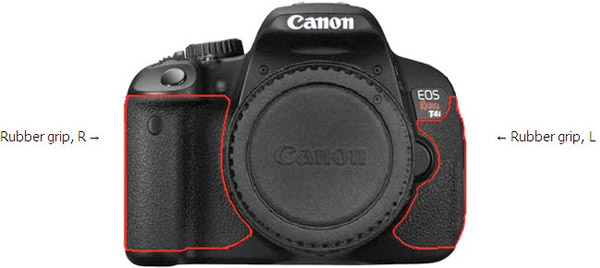 |
| Double the Humpback, Double the Fun |
 |
| Another Big Fish Story |
 |
| Killer Whale spyhopping in BC waters |
 |
| Polar Bear sow with cubs |
Great News! Canon has finally released a new software to address the concern of photographers like myself. I have downloaded the new Firmware 1.1.1 for the EOS-1D X camera and put it through a few tests. So far I am impressed. It does exactly what Canon claims it will do. Very happy Canon is listening to its customers and responding to their suggestions and 'complaints'. They have also included a detailed guide to the new software update to explain the enhancement further. You can view it
here on Canon's website. Click here to download
Firmware from the Canon website.
----------------------------------------------------------------------------------------------------------
Ever since the introduction of the Canon EOS-1 series camera in 1989, I have made this body my main piece of equipment and have upgraded to almost every new model through the decades. I am not the type who craves the 'latest and greatest' gear but once in a while, a new camera introduction can fill a gap in my equipment lineup. So when the EOS-1D X was announced, it seems to be the camera I am looking for so I placed my order and anxiously waited for the delivery. It's finally here and I have put it through some real world, wildlife photo shoots in Alaska and Canada using the Lexar 1000X UDMA 7 memory cards to take full advantage of the 12-14 fps burst rate. My review will not have charts and graphs and this article will not cover all the camera's features, just the major new improvements, and assumes the reader is already familiar with the functionality of the current 1D cameras. It is intended to help those trying to decide whether to upgrade their present 1D bodies by sharing my impression of the new camera from the stand point of a wildlife and travel photographer out in the field. I will be using the 1D MK IV as a reference point. Below are the major features and functionalities of the new camera.
Canon EOS-1D X Features :
- Full Frame 18-megapixel CMOS image sensor
- New mechanical shutter rated up to 400,000 cycles thanks to carbon fiber blades and new drive motor
- Dual DIGIC 5+ imaging processors
- 2nd Gen EOS Integrated Cleaning System
- Third DIGIC 4 processor for RGB Metering
- 100,000 Pixel RGB metering sensor
- Sensitivity settings from ISO 100 - 51,200; expansion available with Low (50), Hi 1 (102,400) and Hi 2 (204,800)
- Advanced new 61-point High Density Reticular Phase Detection AF system with 21 cross-type focusing points in the center of the frame; 5 of which are diagonal cross-type sensors for smaller apertures
- New intelligent EOS iTR AF Tracking and Recognition options
- Burst shooting at 12fps with AF (JPEG and RAW), or up to 14fps with no AF (JPEG only)
- Full 1080p HD video with new ALL-I and IPB compression format options
- Automatic video file splitting when 4GB is reached; video keeps rolling, while new files is created
- 3.2-inch wide LCD with 1,040,000 dots
- Subject Recognition system (AF, Exposure, Auto Lighting Control, AUto Picture Style)
- Optical Correction functions for peripheral illumination, Distortion correction, and CA correction
- Enhanced intelligent OVF with 100% frame coverage, .76x magnification, 20mm eye-point, and expanded ISO indicator; now 5 digits
- Built-in USB 3.0 and gigabit Ethernet ports
- New WFT-E6 Wi-Fi unit (802.11 a/b/g/n)
- New GP-E1 GPS unit
- Dual CF (Compact Flash) card slots
- Li-ion battery pack
In line with previous EOS-1 series cameras, the 1D-X is designed for use in harsh environments. The camera is slightly taller, the egornomics is the same and retains the dust and drip-proof construction of the Mark IV, using a total of 76 seals around buttons and body joints to help keep water and dust out. When combined with Canon L-series EF lenses, the entire package is sealed and weather resistant. The Magnesium alloy body shell stands up to heavy-duty professional use. There is a new charger (LC-E4N) and more powerful battery (LP-E4N) but the LP-E4 battery of the MK IV and the new battery are forward and backward compatible but the chargers are not. The 1D-X has a rear LCD screen that is slightly larger and crisper than the MK IV and features a built-in RJ-45 connector for cabling directly to a LAN network. This is similar to the connector found on the Mark IV, but it is a Gigabit Ethernet port, allowing faster data transfer. The shutter durability is now rated at 400,000 cycles. There is an internal error log, which tracks all camera errors, including the number of shutter release cycles.
One of my primary concerns when I go on a photo shoot is weight and focal length. There is a direct correlation between the two. The longer the lens, the heavier the equipment. I am a wildlife and travel photographer and normally prefer to travel light, with 2 or 3 camera bodies - 1Ds MK III, 1D MK IV and 7D. With the 1D-X and 1D MK IV plus the Series III extenders, I can now get full and cropped frame shots with a focal length of 16-1000mm using the 400mm f/4L DO lens. Together with the 16-35mm f/2.8L II and the 70-200mm f/2.8L IS II or the 70-300mm f/4-5.6L IS or the 100-400mm f/4.5-5.6L IS lenses, most wildlife and travel shots can be tackled plus the entire professional package fits in my medium sized Tamrac bag and I can carry it all day without breaking my back. However, when the Canon EF 200-400mm f/4 + 1.4X extender lens comes out later this year, I will have to carry the larger and heavier Tamrac Expedition 8X bag in order to accommodate the new lens.
After using so many Canon camera models, I am not enamored of technical and marketing hype. The first thing I wanted to test is Canon's claim that the 1D-X's increased processing power, combined with the improvements in sensor design, has permitted an increase in high ISO performance with a gain of two stops over the Mark IV in the normal range (ISO 100 to 51,200) before ISO expansion. And with the dual Digic 5+ processors, unlike the Mark IV, setting High ISO noise reduction to ‘Strong' will not reduce the number of continuous shots that can be captured in a burst, up to 14fps and 10fps with ISO 32,000 or higher. For most action photographers, the realistic number is really 12 fps since the 14 fps requires the mirror lockup.
This is important because when I photograph speeding Hummingbirds and breaching Whales in poor light, shooting with the MK IV at ISO 3200+ and a f/2.8 lens produces images with unacceptable nosie level to me. If the 1D-X can shoot at high ISO settings without a fast lens and still produces photos with respectable noise level, then the upgrade will be worthwhile for me.
The second claim I want to verify is the newly designed 61 point AF system has the ability to detect extreme defocus and correct accordingly. With this increase in AF sensitivity, the 1D-X can now focus in even lower light levels than the Mark IV. Using a single central AF point with a f/2.8 lens, the 1D-X is able to focus in EV -2, equivalent to shooting under the light of the full moon. For easier menu navigation, all AF settings and Custom Functions on the 1D-X are now grouped into one menu tab, offering 6 different cases to choose from. I find some of the options 'redundant' and offer a difference without a distinction.
The new camera is a very complex piece of gear and I have not mastered it yet but I have made use of the ability to change from one set of settings to another at the push of a button. With wildlife you never quite know when the action is going to happen, so you may be shooting with a slow shutter speed when you suddenly need a fast shutter speed to freeze the motion. By using the custom settings I can push one button and immediately switch to a different set of settings, with a fast shutter speed and higher ISO. It’s perfect for subjects that are static, but may start moving suddenly, and saves me having to look down at the camera to change settings.
My first impression of the 1D X's AF system is very good. The viewfinder is bright and AF is lighting fast even under very low light conditions. I tried to AF on many different situations and the camera locked on with little fuss. The high ISO performance is also quite impressive, much better than the MK IV. Noise at ISO 3200 is excellent, ISO 6400 and 12800 are very well under controlled. Even ISO 25600 is not too bad but I'll use ISO 51200 only in an emergency. The burst rate of 12 fps is simply music to my ears. One cannot over-emphasize the difference of 2 additional fps can make. I have gotten shots with the EOS-1D MK IV (10 fps) that I missed with the EOS-7D (8 fps). As with image quality, there is nothing like shooting with the latest EOS-1 camera equipped with the most advanced, full frame sensor.
On the annoying side of things, all previous Canon cameras I have used, come with the blue - and + buttons to view multiple images during playback. With the 1D X, what used to take 2 steps on the MK IV to view multiple images (four) now requires 7 steps. If you want to jump from looking at 4 images to 9 images at one time, you don't even want to know how many steps are involved. If you are listening Canon, please bring back the blue - and + button on the EOS-1D X MK II. In addition, the EOS-1D X cannot AF beyond f/5.6 aperture. This is the first EOS-1 professional camera that has this limitation. I sincerely hope Canon will find a way to remedy this in a future Firmware update.
I am still feeling my way through the EOS-1D X. As a general rule, I never use the Owner's manual with any new camera. Want to see how well a piece of equipment has been engineered and how intuitive it can be from the stand point of the user. This new camera will take me a little bit longer to get used to but I am rather impressed by it so far. I am not into shooting videos so I have no opinion on that part of the camera but judging from my 7D and 1D MK IV's video performance, it should be very good indeed. Will be going out on more photo shoots and posting more updates in the near future. Visit my website
MichaelDanielHo.com to see many more wildlife photos taken with the camera.
Just returned from an European Travel and Canadian Polar Bear Wildlife photo shoots with the EOS-1D X and wrote another review of the camera's amazing high ISO performance. Click
here to see the newer post.






































